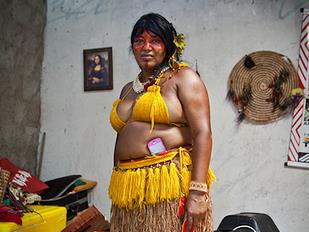Kim Badawi,Urban Indians (detail)
Having recently finished a large scale portrait led project I was looking forward to entering this year’s Kuala Lumpur International Photo Awards for Portrait Photography. I have appreciated the standard of previous winners of the award and wanted to be a part of it.
But when the ‘open for entry’ email came around my heart dropped. In addition to the general portrait category, there is a ‘themed’ portrait category; this year’s theme is Savage and Serene.
It is astonishing to find such a 19th Century concept in a 21st Century photographic competition. Portrait photography is historically linked to anthropology and both anthropological photography and photojournalism have long had an inner conflict for being used as a tool for colonialism. The concept of Savage and Serene conjures imagery of historically negative stereotypes of indigenous and colonised people created by the dominant power structure. It brings to mind the ‘Noble Savage’, the constructed image of the ‘native’ people in wild romanticized attire while relaying a peaceful ignorance to civilization. The words ‘Savage’ and ‘Serene’ nod to vintage photo postcards of enslaved people staged in ‘exotic’ scenes and European clothing, sent to Europeans back home for entertainment.
High quality contemporary photography has, in more recent years, been trying to realign the balance of representation. In particular, photographs coming out of places previously without voices in global mainstream visual culture have been reclaiming the representation of culture. Contemporary African photography is a good example – where the image of the starving child previously dominated the worlds view of Africa, now images of contemporary life across Africa is getting global exposure.
KLPA is not a photojournalism competition, but throughout its six-year lifespan, KLPA has consistently celebrated photojournalistic and documentary portraiture. Documentary photography, for the viewer, tends to present insights into individuals and places new and unknown, unchartered worlds.
Savage and Serene, as a title, is a ready-made stereotype, an imposed reading placed onto a photograph. As a portrait competition, each submitted image is of a person or group of people. To use the word ‘Savage’ to refer to any person could implies that person is ‘regarded as primitive and uncivilized’. If this was a landscape competition, there would be little to gripe about, but in this case we are talking about the construction of imagery representing people and cultures. Although the competition claims to encourage challenging, exploring and debating, Savage and Serene is a phrase that reinforces negative stereotypes.
The photo on KLPA Savage and Serene entry shows a Brazilian woman in traditional dress with a mobile phone tucked into her waistband and a television upended on her floral bedcover. The photo is the work of Kim Badawi, who entered it in last year’s competition.
Badawi was unhappy to learn that it had been used to illustrate such a problematic theme. His project photographed the residents of Aldeia Maracana, a community of indigenous Brazilians who made their home on the grounds of Rio de Janeiro’s defunct Museum of the Indian and were threatened with eviction under plans to extend Maracana Stadium for the FIFA World Cup 2014.
Badawi is unhappy about his image being used to promote the Savage and Serene. While photo-competitions typically have an entry condition that allows them to use entries for promotional purposes he intends to complain at being associated with this theme.
‘They are seeking provocative imagery while disguising it as a human-rights themed contest. It’s obviously a contest aimed at encouraging shocking portraits and photojournalism sensationalism,’ he told me.
As anyone who has worked in design or advertising knows, for a theme or campaign to be given public life there must have been some kind of discussion and approval process. KLPA is an international photography award with project managers based and educated in the UK and Malaysia. Previous judges having been anthropological experts in visual communication. Did none of these people raise an alarm bell?
The choice of words ‘Savage and Serene’ is regressive. This is not the kind of international photography that I want to create and support.




